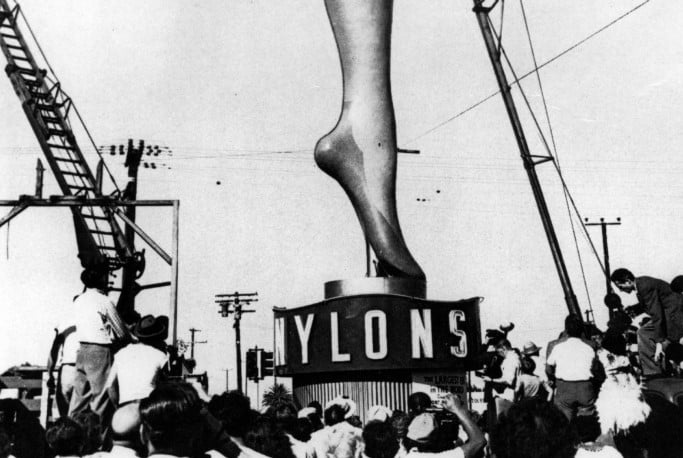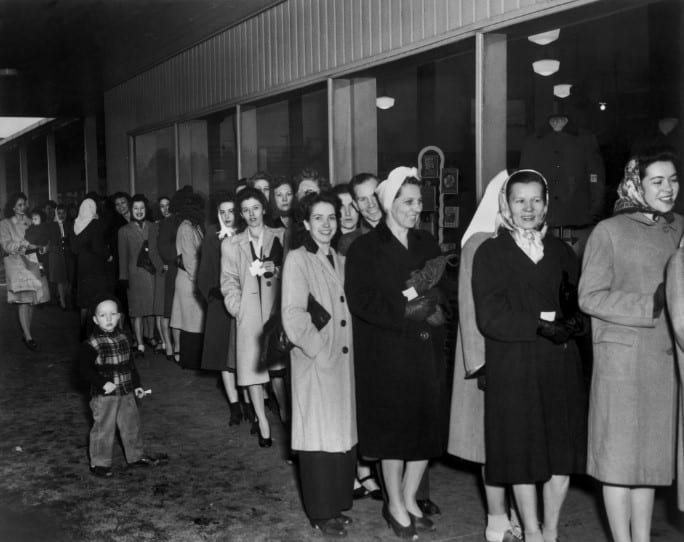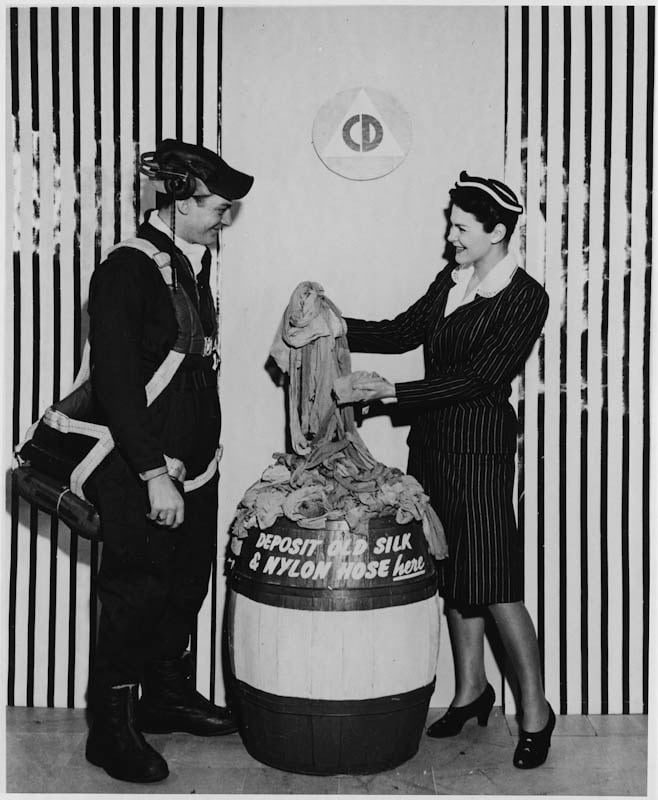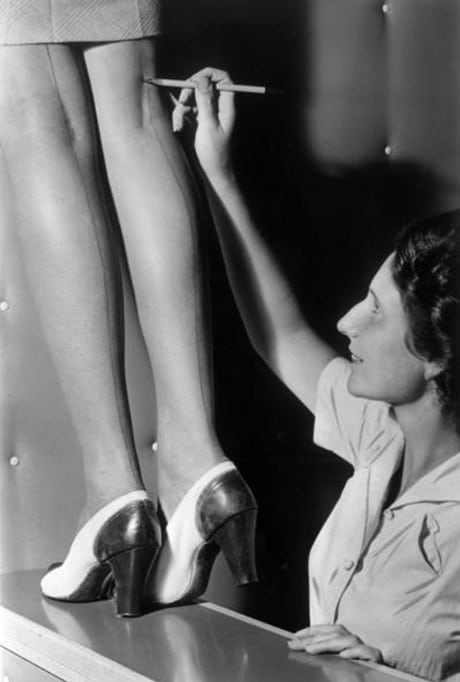The Popularity Of Paint On Hosiery During War Years
During the war years, when supplies were scarce, women on both sides of the Atlantic had to get inventive with their fashion. One creative solution that emerged was “paint on hosiery.”
With traditional stockings hard to find, women turned to using makeup or special liquid solutions to mimic the look of stockings on their legs. This trend reflected the resourcefulness of women during a challenging time in history.
Let’s dive deeper into this fascinating aspect of wartime fashion.
Stockings became scarce due to the war

Nylon stockings were modeled for the first time at the 1939 New York World’s Fair – they were more durable than silk and rayon stockings which were prone to runs and it was washable as well.
In no time, nylon stockings became all the rage and were selling out at department stores across the United States.
But just as quickly as they became popular, nylon stockings disappeared from stores when World War II started. That’s because silk and nylon were needed to make important things for the war, like parachutes, nets, and ropes.
The change started in the 1940s, a time when the world faced tough challenges during the war. Even though times were hard, looking good was still important. It was a way for people to show hope and strength during difficult times.

By 1941, factories were making stuff for the war, so making regular clothes became hard. There weren’t enough skilled workers, and materials were running low.
In January 1941, they even banned using silk for clothes, including stockings. Other fabrics were strictly controlled too, with rationing.
As the war went on, it got harder to keep stockings in good shape. But in the UK, people had the “Blitz Spirit” – they believed in making the best of what they had.
Women treasured their few pairs of stockings and hired special people to fix them up when they got holes.
Women in service jobs only got new stockings after their old ones had a bunch of holes – sometimes as many as twenty, depending on how many were available and what their bosses said.
Women faced challenges with scarce stockings

Back in the 1940s, it was against the social norm for women to go out bare-legged, except maybe at home or at the beach. So, when stockings became hard to find during the war, it was a bigger deal than we might think today.
Lots of young women even went without stockings in the summer to save them. In Australia, the government said bosses couldn’t make women wear stockings at work. Slowly, people started to get used to the idea of not always wearing stockings because of the war.

In Australia, a little sun could easily get a tan and improve the look of white legs, but in Britain, sunny days were rare. So, women got creative to mimic the look of stockings. They experimented with gravy browning, walnut juice, tea, iodine, and even brown shoe polish to fake the look of stockings.
Bottles of liquid stocking appeared widely on the market

In August 1941, a smart woman showed another how to draw a “seam” on the leg using an eyebrow pencil. This trick was done after applying something called “liquid stockings,” which was basically just nude-colored makeup.
Liquid stockings acted like a foundation for your legs, giving the illusion of wearing hosiery when you weren’t actually wearing any. It was a clever way for women to keep up appearances even when stockings were hard to come by.
Salons and department stores across the US started selling bottles of liquid stockings. These bottles offered an alternative to traditional stockings, with one bottle claiming to provide around 24 pairs of “stockings.”
An advertisement from 1942 promoted the product with the slogan “Paint a limb and save silk,” targeting women who were conscious of supporting the war effort.

Leg paints hit the market in a big way, but early versions were tough to apply evenly and would often run when it rained, leaving stains on dresses.
However, big cosmetic names like Elizabeth Arden, Helena Rubinstein, Max Factor, and L’Oréal stepped up with better versions. They claimed their products wouldn’t stain and were resistant to water, but in reality, they all left some residue on clothes and shoes.
A bottle of liquid stockings cost about the same as a pair of rayon stockings but lasted longer, as long as you took good care of them and were lucky enough not to snag or run them too often.
One of the first brands, called “Nina Makeup,” came from England and offered six different shades.
“No longer will Lulu Jane have to worry about snags and runs, just soap and water, for the stuff comes off at the slightest washing. You can even draw your own seams, only you are warned not to draw them too straight or they won’t look natural. The stuff even smells good.”
Paint on hosiery services became popular

Liquid stockings were not an easy fix for all. One woman, seeking advice in June 1943, wrote to the Times-Dispatch about her struggle.
“I am wearing liquid stockings to save my rayons, but cannot stand the feel of shoes without stockings. I have some “foot socks” to wear under my shoes, but as some of my shoes are perforated or have openings, they show. Can I get them in various colors or have you a remedy to suggest?
The response suggested using a bit of liquid stocking on her foot socks. It would dye them the same color, look the same, and wash out easily with soap and water.

For women unsure about which product to choose or how to apply it, there were plenty of options available.
Brands like Ann Barton’s Leg Make-up, Harriet Hubbard Ayer’s Stocking Lotion, Patrick’s Leg Art, Leg Charm from Cosmetic House, Helena Rubinstein’s Leg Stick, and Max Factor’s Pan-Cake Make-up offered choices.
As leg makeup became popular, women sought guidance on how to apply it. Some visited leg makeup bars in department stores, while others turned to beauty parlors for professional applications. These sessions typically took about half an hour and cost $1 per leg.

